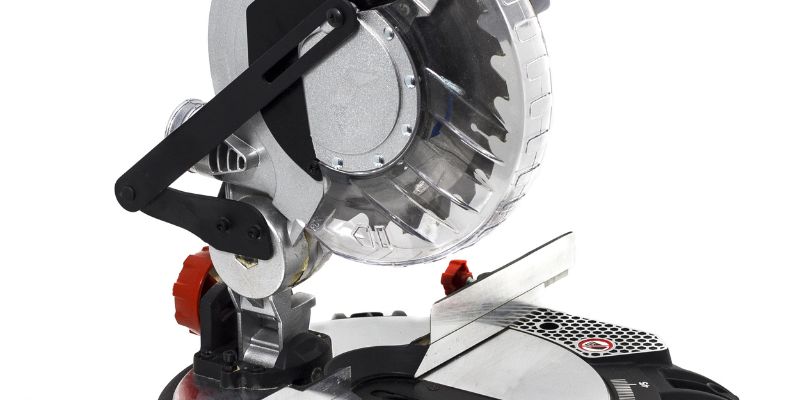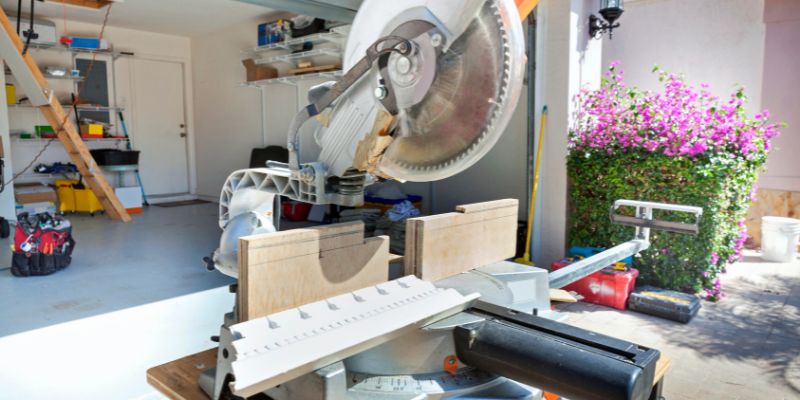A miter saw is a power tool with a circular blade mounted on an arm that can make precise angle cuts. It typically has a handle, a trigger for starting the blade, a fence to hold the material in place, and a base to support the workpiece.
The blade can be adjusted to make angled cuts, such as miter cuts and bevel cuts, which makes it useful for woodworking and carpentry projects. A miter saw is a versatile and essential tool for anyone working on DIY projects or professional construction jobs.
Its ability to make accurate and clean cuts at various angles and bevels ensures precise finished products. Whether you’re cutting trim, moldings, or framing lumber, a miter saw is a valuable addition to any workshop. With its straightforward design and ease of operation, it is an indispensable tool for anyone looking to achieve professional-grade results.
Miter Saw Anatomy: A Visual Guide
Basic Components Of A Miter Saw
The miter saw is an essential tool for precision cutting in woodworking and carpentry. It consists of several basic components that enable accurate and efficient cutting. The main components of a miter saw include:
- Blade: The circular blade is the cutting element of the miter saw, designed for making accurate angled and straight cuts.
- Base: The flat surface where the workpiece is placed and secured for cutting.
- Arbor and blade guard: The arbor holds the blade in place, and the blade guard protects the user from contact with the spinning blade.
- Fence: A vertical guide that provides support and ensures straight cuts.
- Miter gauge: A protractor-like component used for adjusting the angle of the blade for miter cuts.
Exploring The Saw’s Design Features
The design of a miter saw showcases several key features that enhance its functionality and versatility:
- Bevel adjustment: Allows the blade to tilt to the left or right for bevel cuts.
- Dust collection system: Helps in minimizing sawdust and keeping the work area clean.
- Trigger and handle: The trigger controls the power of the blade, and the handle provides a comfortable grip for maneuvering the saw.
- Laser guide: Some miter saws are equipped with a laser guide to assist with precise cutting alignment.
Typical Sizes And Shapes Of Miter Saws
Miter saws come in various sizes and shapes to accommodate different cutting needs:
| Size | Shape |
|---|---|
| 10-inch | Compact and portable, suitable for light-duty cutting tasks. |
| 12-inch | Offers larger cutting capacity and is ideal for professional woodworking projects. |

Comprehend The Functions Of A Miter Saw.
A miter saw is an essential tool in any woodworker’s arsenal, providing the ability to make precise angled cuts with ease. To truly grasp the capabilities of a miter saw, it’s crucial to understand how its various functions contribute to its overall effectiveness.
How Blade Angles Work
A miter saw’s ability to make precise angled cuts is made possible by its adjustable blade angles. This feature allows the user to tilt the blade both to the left and right, enabling cuts at various angles, from standard 90-degree cuts to complex bevel cuts. By understanding how to manipulate the blade angles, woodworkers can achieve the precision and versatility they need for their projects.
The Role Of A Miter Saw’s Base
The base of a miter saw serves as the foundation for stability and support during cuts. It is designed to pivot left and right, allowing for miter cuts at different angles. The presence of a sturdy and adjustable base is critical in ensuring that cuts are accurate and consistent. A well-constructed base contributes to the overall reliability and precision of the miter saw.
Motor Types And Power Options
When it comes to miter saws, the type of motor and power options play a significant role in determining the tool’s performance. Most miter saws are equipped with either a direct drive or belt drive motor. Direct drive motors deliver immediate power to the blade, while belt drive motors transfer energy through a belt, resulting in smoother cutting. The power options available, such as corded or cordless models, offer flexibility and convenience based on the user’s specific needs and workspace requirements.
A Closer Look At Miter Saw Models
When it comes to miter saws, it’s important to understand the different models available on the market. A closer look at miter saw models allows you to make an informed decision when purchasing one for your woodworking projects. In this segment, we will delve into the various features and distinctions between sliding versus non-sliding miter saws, single bevel versus double bevel distinctions, and cordless miter saws versus corded variants.
Sliding Versus Non-sliding Miter Saws
Sliding miter saws and non-sliding miter saws each have their unique advantages. A sliding miter saw allows the blade to move forward and backward, enabling it to make wider cuts. On the other hand, a non-sliding miter saw has a limited range of motion but is often more affordable and suitable for smaller woodworking projects.
Single Bevel Vs. Double Bevel Distinctions
When it comes to bevels, miter saws can be classified as single bevel or double bevel. A single bevel saw tilts in one direction, whereas a double bevel saw can tilt in both directions. This feature is beneficial for making complex cuts without repositioning the workpiece, saving time and effort.
Cordless Miter Saws Versus Corded Variants
Cordless miter saws offer the convenience of portability and freedom from power cords, making them ideal for job sites or locations without easy access to power outlets. Conversely, corded miter saws provide consistent power without the need for recharging, making them suitable for prolonged use and heavy-duty cutting tasks.
What Does A Miter Saw Look Like In Action
Visualizing The Cutting Process
When you imagine a miter saw in action, you might picture a highly efficient and precise cutting machine. The blade of a miter saw descends smoothly through the material, creating perfectly angled cuts with remarkable accuracy. It’s a visual symphony of power and precision as it effortlessly slices through wood, metal, or plastic.
Real-life Applications And Saw Setups
A miter saw in action can be utilized for a myriad of applications, from framing to trim work. It adapts to various angles and bevels, easily adjusting to accommodate a variety of cutting needs. The saw setup plays a crucial role in determining the accuracy and quality of the cuts made. Carpenters and woodworkers often customize the saw settings to match the specific project requirements, ensuring optimal results.
Miter Saws In The Workshop Environment
Within the workshop environment, miter saws serve as invaluable tools for professionals and DIY enthusiasts alike. Their robust construction and user-friendly design make them essential for creating precise cuts with minimum effort. The workshop resonates with the sound of the miter saw’s blade as it effortlessly cuts through lumber, bringing projects to life with speed and accuracy.
Selecting Your Miter Saw
When selecting a miter saw, considering the key features, styles for specific projects, and safety accessories is crucial to ensure you make the right choice for your needs. Let’s take a closer look at these factors to help you make an informed decision.
Key Features To Consider For Purchase
When purchasing a miter saw, it’s essential to carefully consider the key features to ensure it meets your specific needs. Here are some key features to keep in mind:
- Blade Size: Ensure the miter saw has a suitable blade size for your cutting needs.
- Motor Power: Look for a miter saw with sufficient motor power to handle your intended projects.
- Bevel Capacity: Consider the bevel capacity for making angled cuts.
- Dust Collection: Opt for a miter saw with effective dust collection to maintain a clean work environment.
- Accuracy and Precision: Look for features that ensure accuracy and precision in cuts, such as laser guides or LED lights.
Miter Saw Styles For Specific Projects
Depending on the types of projects you’ll be tackling, different miter saw styles may be more suitable. Here are some common miter saw styles for specific projects:
- Compound Miter Saw: Ideal for bevel and miter cuts, making it suitable for crown molding and picture frames.
- Sliding Compound Miter Saw: Offers the ability to cut wider boards due to its sliding feature, great for larger-scale projects.
- Basic Miter Saw: Simple and straightforward, suitable for general woodworking and smaller projects.
Safety Accessories And Their Appearance
When it comes to using a miter saw, safety should always be a top priority. Here are some essential safety accessories and their appearance:
| Safety Accessory | Appearance |
|---|---|
| Eye Protection: | Safety goggles or glasses to protect the eyes from flying debris. |
| Hearing Protection: | Earplugs or earmuffs to safeguard against loud noise. |
| Dust Mask: | A mask to prevent inhalation of sawdust and particles. |
| Push Stick: | A device used to guide the workpiece through the saw, keeping your hands at a safe distance. |
Upkeep And Miter Saw Maintenance
When it comes to ensuring the longevity and performance of your miter saw, regular maintenance and care are essential. By implementing proper upkeep and maintenance procedures, you can extend the lifespan of your miter saw and optimize its precision and safety. From basic cleaning and blade replacement to long-term storage, understanding the necessary maintenance tasks will help you keep your miter saw in pristine condition.
Basic Cleaning And Care Visuals
Basic cleaning and care are crucial for the efficient operation of your miter saw. Here are some visual cues to guide you through the process:
- Wipe down the saw surfaces with a clean, dry cloth to remove sawdust and debris.
- Inspect the blade guard and other safety components for any signs of wear or damage.
- Use a vacuum or compressed air to remove dust and debris from the blade guard, motor housing, and other critical areas.
Blade Replacement And Calibration Cues
Regular blade replacement and calibration are essential for maintaining the accuracy and safety of your miter saw. Here are some cues to help you determine when it’s time for blade replacement or recalibration:
- Inspect the blade for dullness, chipping, or warping, which can affect the quality of cuts.
- Use a square or angle gauge to check the accuracy of miter and bevel adjustments.
- Listen for unusual sounds or vibrations during operation, which may indicate blade or calibration issues.
Long-term Storage And Appearance Preservation
Proper long-term storage and appearance preservation practices are essential for keeping your miter saw in prime condition, especially during periods of infrequent use. Consider the following tips:
- Clean and lubricate the saw before storing it to prevent corrosion and rust.
- Store the saw in a dry, temperature-controlled environment to prevent moisture damage.
- Use a cover or case to protect the saw from dust and potential impacts during storage.

Frequently Asked Questions On What Does A Miter Saw Look Like
What Is A Miter Saw Used For?
A miter saw is primarily used for making accurate crosscuts and miter cuts in a workpiece. It is commonly used in woodworking, carpentry, and picture framing for cutting angles and precise joints.
What Are The Different Types Of Miter Saws?
The different types of miter saws include basic miter saws, compound miter saws, dual compound miter saws, and sliding compound miter saws. Each type offers different features and cutting capabilities suited for various woodworking projects.
How Do I Use A Miter Saw Safely?
To use a miter saw safely, always wear eye protection and follow the manufacturer’s instructions. Secure the workpiece, keep your hands clear of the blade, and use the appropriate safety guards. Additionally, ensure the saw is on a stable surface and use a clamp for extra stability.
What Are The Key Features To Look For In A Miter Saw?
Key features to consider when choosing a miter saw include the blade size, cutting capacity, bevel and miter angle range, motor power, laser guides for accuracy, dust collection system, and ease of blade changes. Selecting a miter saw with these features can enhance your woodworking experience.
Conclusion
In wrapping up, a miter saw is an essential tool for precise and angled cuts. Understanding its components and functionalities is critical for efficiency and safety. Learning to recognize the different types and sizes of miter saws will help you select the best one for your projects.
Having this knowledge will also empower you to use the tool effectively, making your woodworking endeavors more successful and enjoyable.


